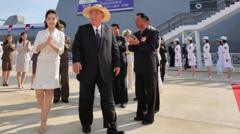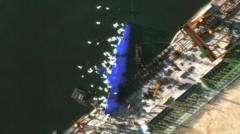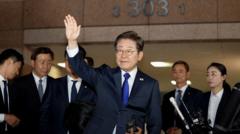The incident surrounding North Korea's new warship, which capsized during its launch but was quickly repaired and relaunched, underscores Kim Jong Un's adaptive leadership and propaganda techniques. By publicizing the failures, Kim aims to bolster regime loyalty and project military ambitions, particularly in establishing a nuclear-capable navy.
North Korea's Warship Fiasco: A Reflection of Kim Jong Un's Leadership Tactics

North Korea's Warship Fiasco: A Reflection of Kim Jong Un's Leadership Tactics
The recent capsizing and swift relaunching of North Korea's new warship reveal the regime's focus on military advancement and propaganda strategies under Kim Jong Un.
In a remarkable incident that captivated global attention, North Korea's newly built warship capsized shortly after its launch last month. While the event itself did not result in casualties and the damage was reportedly minor, its implications for Kim Jong Un’s regime are profound.
Media outlets closely monitored every step, from the ship's initial sinking to its subsequent relaunching just weeks later. The level of scrutiny raises an important question: why does an incident devoid of loss of life draw such international intrigue?
The answer lies in Kim Jong Un’s response to the incident. He labeled the capsizing as a "criminal act," one that jeopardized the dignity of the nation. In a swift move, Kim ordered immediate repairs while holding those responsible accountable – leading to the arrest of several party officials. This reaction points to a critical aspect of the North Korean regime: the importance of public perception and loyalty among its citizens.
Experts note that North Korea’s military strategy emphasizes acquiring a formidable naval presence, alongside its existing nuclear arsenal. Although the North’s navy lags behind those of South Korea, Japan, and the United States, Kim believes strengthening sea capabilities is vital for national security. The new warship is part of a broader initiative to modernize North Korea's military sea power, with the capability to launch nuclear missiles theoretically.
Retired South Korean navy captain Choi Il highlighted the embarrassment the capsizing incident posed not only for Kim but also for North Korea's shipbuilding capabilities. It was an unusual circumstance for a destroyer, raising questions about the quality of craftsmanship amid ongoing sanctions and restrictions.
However, analysts like Rachel Minyoung Lee argue that Kim's visible anger also plays into a calculated propaganda strategy. In recent years, North Korean leadership has shifted from concealing failures to transparently acknowledging them, thereby framing accountability as a demonstration of effective governance. This approach may seem counterintuitive, but it effectively manages public opinion in a regime where information flow is tightly controlled.
Despite the initial embarrassment, the rapid repair of the warship and reinvigoration of the narrative allows the regime to position itself as resilient. The event was repackaged to highlight a worker’s dedication, turning tragedy into a rallying point for loyalty to Kim Jong Un and the state. This task of narrative management illustrates Kim's innovative tactics to maintain control over public sentiment.
The quick recovery and rehabilitation of the warship stood as a testament to North Korea's resolve, according to experts. They noted how efficiently they turned a setback into a political narrative emphasizing progress. Critics and analysts remain wary, however, recognizing that the development of a nuclear-capable navy transforms North Korea's military scope and presence beyond its borders, necessitating global vigilance in response to its aspirations.
As Kim Jong Un seeks to bolster his regime’s military prowess and public loyalty, the implications of this incident extend far beyond the shores of North Korea, marking a potential shift in maritime military strategy amidst an already tense geopolitical landscape.





















